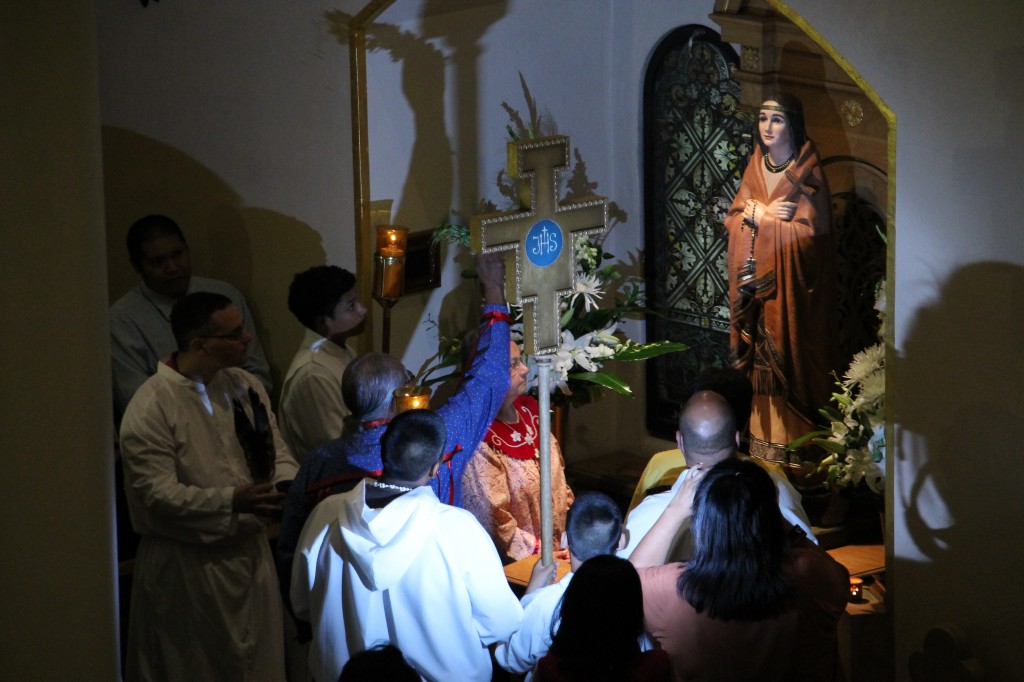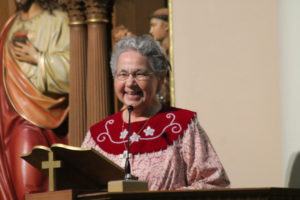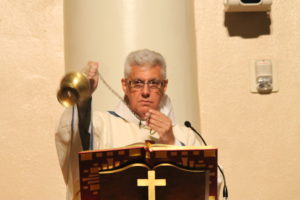

It took less than an hour for a new statue to blend in with those that lined the side walls of St. Mary’s Basilica for years.
Catholics from throughout Arizona respectfully waited their turn to pray in front of a new statue of St. Kateri Tekakwitha immediately following a July 14 Mass celebrating her feast day. Many touched her face, which a bout with smallpox disfigured for much of her life. It cleared up shortly after her death.
Others caressed her from head to toe. A woman gently placed a rosary at her feet. Isabelle Sisto left a traditional basket meant to carry food as a gift from the San Carlos Apache tribe. Part of St. Kateri’s sacrifice as a Christian honoring the Sabbath’s day of rest meant she often went without eating.
Sisto counted herself among 10 members from her tribe in the Diocese of Tucson who braved monsoon weather to attend the feast day celebration.
[quote_box_right]St. Kateri resources:
- National Kateri shrine
- Tekakwitha conference
- Song: “Kateri, Tell Us a Story”
- Archived article on her previewing her canonization[/quote_box_right]“We believe that she’s Native and she represents all the native people,” Sisto told The Catholic Sun. “We still have our traditional prayers too.”
She said they involve the sign of the cross, feathers and yellow powder that creates the smoke that they believe carries their prayer. The liturgy used traditional incense and allowed Joseph Enos, an elder from the Tohono ó odham nation behind the altar to bless the four cardinal directions.
He later offered a Native blessing of the statue too. They were among at least 300 plus six priests who filled the basilica for a special evening Mass. It brought together various tribes in prayer, song, rhythm and custom to honor the world’s first Native American saint. Pope Benedict XVI canonized her in 2012.
An intertribal choir alternated with a small drum circle during a musical prelude.

“It’s a time of rejoicing, a time of giving thanks,” Sr. Kateri Mitchell, executive director of the Tekakwitha Conference said in pre-liturgy remarks. She added that it was appropriate to gather for a eucharistic celebration.
“The Eucharist, for her, was her way in which she met her Christ and the Eucharist is what binds us all together,” Sr. Mitchell said. “She’s a healer and one who gathers her people together.”
The liturgy’s language spoke to those with English and Tohono ó odham tongues with sign language sprinkled throughout.
[quote_box_left]RELATED VIDEOS:
- Celebrating St. Kateri
- Native American choirs
- The Goodnight Song[/quote_box_left]Franciscan Father Vince Mesi, pastor of St. Mary’s Basilica, continued to highlight St. Kateri’s life and impact in a homily that was both spoken and sung. He said she was filled with the Lord’s counsel to be clean of heart and strove to put God at the center of her life.
At 19, St. Kateri refused to be converted to a non-Christian religion and was later baptized on Easter Sunday, but endured much suffering because of it.
She wanted to start an order, but a priest’s advice led her to bring the love of God to others as a lay witness instead. Fr. Mesi finds a deeper inspiration that the many miracles attributed to her intercession following her death.

“I think about a strong reminder to me, hopefully to all of us, that we need to be steadfast to the love of God,” Fr. Mesi said and let nothing get in the way.
He proceeded to sing the responsorial psalm — Psalm 16 — which he said described St. Kateri’s inner spirit. He also invited everyone to re-commit themselves to single-hearted service to God’s love and His people.
Massgoers showed a Christian love during a dinner reception in the basilica’s basement with overflow seating arranged in circles, a presentation of symbolic gifts and a musical showcase.
The St. Kateri celebration completed a trio of monthly liturgies allowing some of the diocese’s 15 ethnic communities to visit St. Mary’s Basilica leading up to its 2015 centennial and celebrate their culture. The Tongan community gathered in June and the Filipino community gathered in May.





